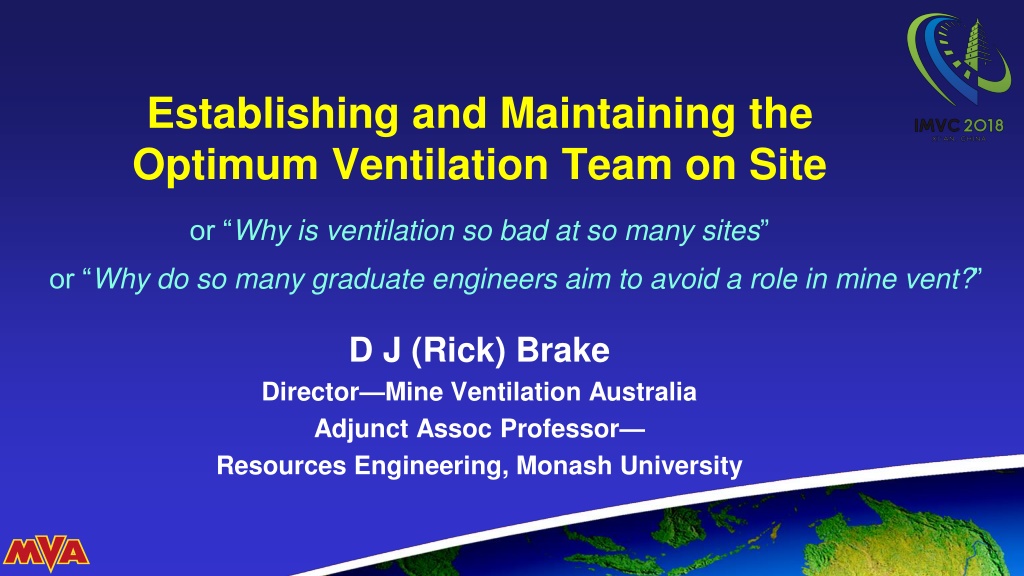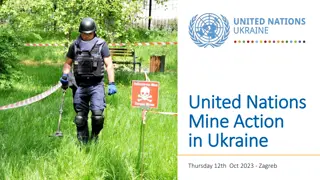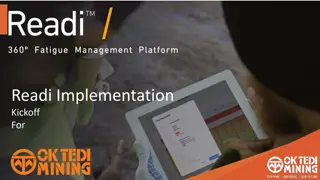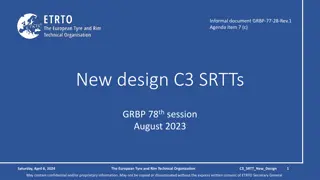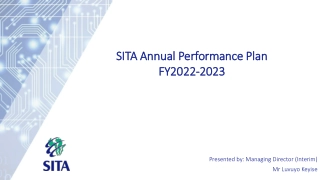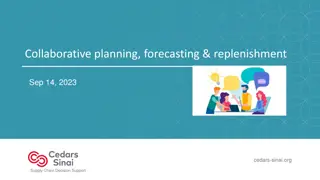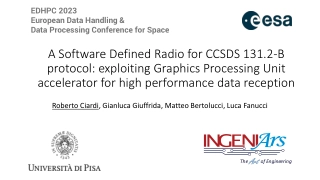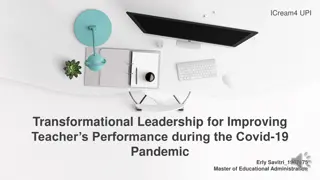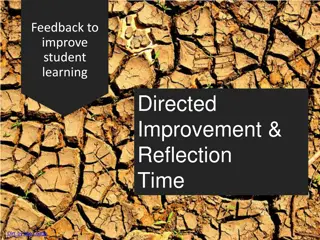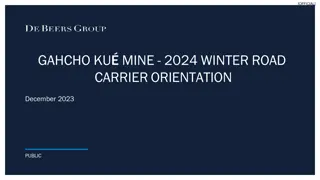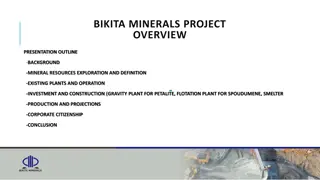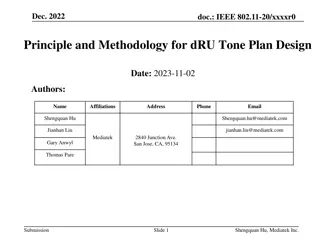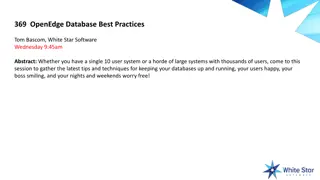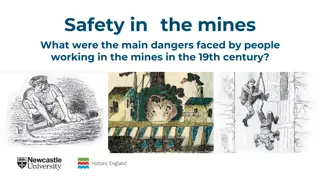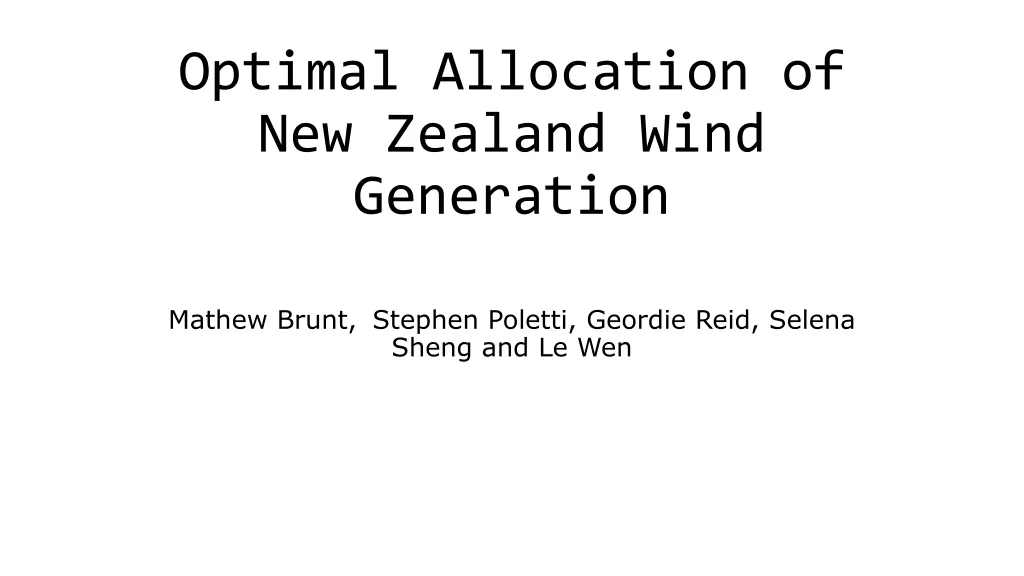Enhancing Mine Ventilation for Optimal Performance
Discover the key role of ventilation in mining operations, debunking misconceptions about its importance. Learn how good ventilation practices contribute value to a mine, improve safety, reduce costs, and boost productivity. Explore the crucial considerations in establishing and maintaining an efficient ventilation team on site.
Download Presentation
Please find below an Image/Link to download the presentation.
The content on the website is provided AS IS for your information and personal use only. It may not be sold, licensed, or shared on other websites without obtaining consent from the author. Download presentation by click this link. If you encounter any issues during the download, it is possible that the publisher has removed the file from their server.
Presentation Transcript
Establishing and Maintaining the Optimum Ventilation Team on Site or Why is ventilation so bad at so many sites or Why do so many graduate engineers aim to avoid a role in mine vent? D J (Rick) Brake Director Mine Ventilation Australia Adjunct Assoc Professor Resources Engineering, Monash University
Outline How does good ventilation add value to a mine? Key considerations providing vent support for a mine New developments that will affect role of vent officer Successful and unsuccessful organisations models for vent support Generalised model for large vent team on site Factors affecting offsite vent support
Some mine managers have low opinion of mine vent. Why this incorrect opinion? Significant cost to the operation with little value added Mining is not a game for sooks The trouble with introducing cooling is miners get used to it Complying with vent stds reduces operational flexibility Extending vent circuits in timely manner delays prod Prefer minimal vent stds as can be selective about compliance Vent is something even a trained monkey could do Why put someone other than fresh graduate in the role? Why spend good money on ventilation training?
How does good ventilation practice actually add value to a mine? Reduction in capital costs of development, primary fans, cooling, heating, ventilation controls Reduction in operating costs (incl power) of these Improved devt and production rates so higher revenues Safer environment so fewer accidents & disasters Better long-term health outcomes, lower health costs & insurances More productive environment (heat, visibility ) Better morale, reduced absenteeism and turnover Social licence to operate
Who adds the value in a mine: planners or operators?
Key considerations in providing ventilation support for a mine How much vent competence required to operate the mine? Legal requirements for vent and for vent officer (if any) Vent capability needs: onsite v offsite Fly in Fly out (FIFO) or residential operation Domestic or foreign owner of the mine: training of national staff Role of the Ventilation Control Plan How will more complex ventilation support be provided? How much autonomy to individual sites Group policies Is vent person rotational role or career role?
How much vent competence is required to operate the mine? What are the ventilation related risks to: Safety and health? Mine production? Capital and operating costs? PR & HR The larger the ventilation related risks, the higher the level of ventilation competence required
What are the legal requirements for ventilation and for vent officer How demanding are the legal requirements for vent? Is the role of the ventilation officer a statutory one? If so, what are the legal restrictions on this role? What formal quals are required by the vent officer?
Govt and regulators policies towards VO is changing in Australia-why? Concerns about resurgence of CWP in Qld, USA Concerns about silica doses: mining and tunnelling Concerns about DPM, NO2 Concerns about heat stress Concerns about fires & explosions (e.g NZ Pike River) Negative publicity & hence pressure on politicians
Exciting new developments for the role VO in Queensland! Any metal mine > 20 persons will need a VO meeting BoE competency The ventilation officer for the mine is (legally) responsible for (a) the implementation of the mine s ventilation system; and (b) the establishment of effective standards of ventilation for the mine The Chief Inspector has stated that the VO in a metal mine should be a senior person in the mine hierarchy VO cannot be VO of more than 1 mine w/o approval Chief Inspector If VO is absent > 14 days, must be replaced by another approved VO This will flow through the rest of Australia then elsewhere. Why? Default position is to meet the (reasonably) highest of the stds in use.
Vent capability needs: onsite v offsite What vent design capability required? First principles design from scratch ? Incremental new design, e.g. extending into new area Redesign/modification/adjustment only Following someone else s design What vent decisions need to be made on site? What vent decisions can be made off site? Is vent support needed 24/7, 12/7 or 8/5 (residential) For FIFO, is a back to back needed?
Domestic or Foreign Mine Owner Foreign companies often under significant pressure to train locals Expat visas may be restricted esp over time Hence bigger emphasis on national staff training, mentoring and technical skills and professional development Impacts on structure of on- and off-site vent team
Role of the Ventilation Control Plan? VCP will become mandatory Critically important development in mine vent Will result in better vent standards, continuous improvement, higher status for the profession, more resources, funding & training, career opportunities Avoid excessive scope
How will more complex ventilation support be provided? Senior career ventilation engineer on site Group Ventilation Engineer (GVE) Long-term relationship Vent consultant (acting as GVE) Ad hoc consultant(s), brought in as required
How much autonomy to individual sites Some mining groups like centralised approach to issues including technical issues Some preferred devolved approach so each mine is autonomous Trend for bigger companies will be towards corporate responsibility hence more centralised approach due to corporate risks: e.g. explosions, tailings dam failures, etc
Group Policies Senior manager fired over this
Is position of vent person rotational role or career role? How long will the person be in this role? Are there further career opportunities on site, or within the group? How will the individual(s) be mentored? By who? What formal and informal training will be offered or required? Multi-skilled (e.g. dual role of vent and D&B same time), or Rotated through the role (vent then D&B consecutively)
Successful models for vent support A. Minimum onsite vent support (e.g. graduate eng) backed up by Competent, experienced GVE Long-term relationship with competent, experienced consultant B. (Semi) self-supporting competent, experienced vent team on site
Unsuccessful models for vent support A. Inexperienced site engineer with no competent tech support or oversight on or off site B. Inexperienced site engineer AND who must, based on their own inexperience, determine when to bring in outside support & justify this to management C. Inexperienced site engineer backed up by incompetent site supervisor, e.g. tech services supt
Model for self-contained onsite vent department Ventilation superintendent Technical Expert expat onsite vent eng Specialist external consultants as req d Ventilation engineer planning Ventilation engineer projects Vent Senior vent off-Operations technician- Instruments Vent officer- Area A Vent officer- Area B Vent officer- Area C Ditto Vent lab
Factors affecting ability to provide ventilation support from offsite Language issues esp local engineers proficiency in oral & written English Existing site practices: how far are they off good practice? Difficulties travelling to site e.g. visas, flight schedules, vaccinations Time required to get to site Time zone differences between site and offsite Company & government policies on using offsite labour Communications esp video conferencing
Offsite ventilation support Group Ventilation Engineer or Long-term Ventilation Consultant Key roles: Technical supervision but not daily interference Mentoring Training Career development Input into performance reviews esp of onsite vent supt Creation and implementation of VCP, other group standards Performing complex vent design Assistance with equipment specifications, tender adjudication, performance testing Engagement of specialist consultants as reqd
Group Ventilation Engineer or Consultant? I do believe GVE is preferable over consultant if practicable However, GVE needs strong organisational support: Attending conferences, seminars Publishing papers Visiting variety of other mine sites for ideas & benchmarking People skills development Equipment and travel to site Site support of his role Salary and benefits
What makes a great engineer? Behaviours and attributes that lead to success Good communication skills Client focus Deep thinking Open minded Experienced Current Cost conscious On time, on budget Available Source: McCarthy P, 2015. What makes a great engineer . AusIMM Bulletin. April.
Summary Good ventilation design & practice adds lots of value to a mine in many ways There are many factors that impact on the optimum size and structure of vent dept on site Exciting new developments will affect role of vent officer in Australia and probably elsewhere There are successful and unsuccessful organisational models for vent support All site vent teams need offsite support of some sort Take into account the factors affecting best way to provide offsite support
D J (Rick) Brake Director Mine Ventilation Australia Adjunct Assoc Professor Resources Engineering, Monash University
